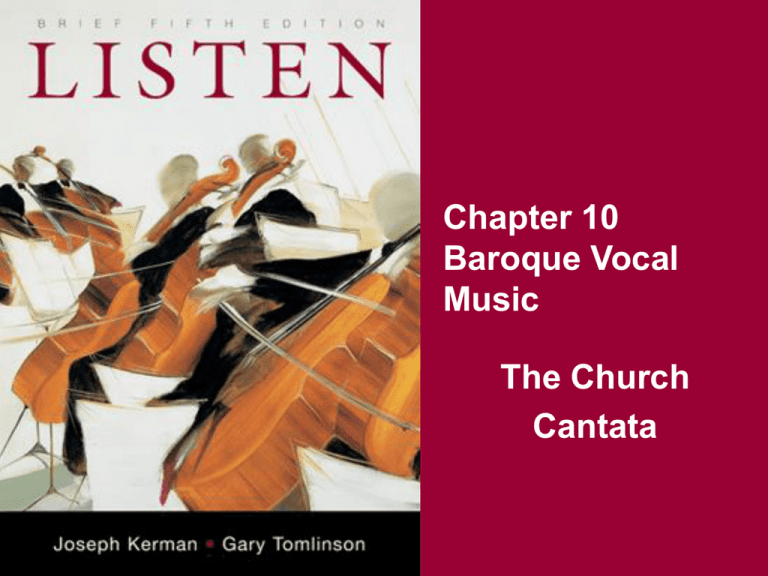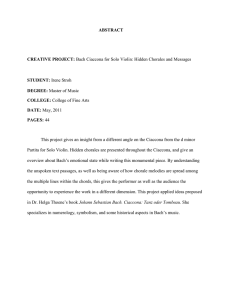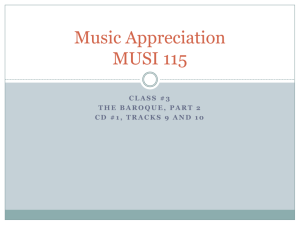Chapter 10 Baroque Vocal Music The Church
advertisement

Chapter 10 Baroque Vocal Music The Church Cantata Key Terms Church cantata Chorales Gapped chorale The Church Cantata Second in importance to oratorio Cantata = work in several movements for voices & instruments • Could use sacred or secular texts • Featured solo voice(s) & sometimes chorus Church cantata • Always based on sacred text • Used solo voices; usually used chorus • Texts for Lutheran church cantatas had to fit with fixed Bible readings for each Sunday of the church year The Lutheran Chorale Most Lutheran cantatas use chorales Chorale = German congregational hymn Martin Luther favored hymn singing–he wanted audience participation From that time on, the body of German hymns grew steadily Hymns well-known & well-loved by Lutheran congregations When used in cantatas, chorales provided rich source of associations Cantatas & Chorales Cantatas used chorales in several ways • Final movement of typical Bach cantata used single verse of a chorale sung straight through with simple harmonization • Longer choruses could present chorale phrases one by one, with a point of imitation on each one • Gapped chorales presented chorale melody in spurts, with a continuously recurring ritornellolike idea in between phrases Bach Cantatas Bach wrote over 200 cantatas, most of them for church In Leipzig Bach had to produce cantatas for the entire church year Cantatas were used for every Sunday service at the Thomaskirche • Performed between the Gospel reading & the sermon • Provided reflection on the reading in preparation for the all-important sermon Typical Bach Cantata Began with substantial chorus • Usually based on a chorale tune (same as the one used at the end) Continued with recitatives & arias for solo voices Concluded with straightforward harmonized chorale • Carefully selected to fit with Bible readings for that Sunday Bach, Cantata No. 4, “Christ lag in Todesbanden” (1) Written in 1707 while Bach was still a small-town organist Cantata for Easter Sunday • Surprisingly serious & stern for Easter • Reflects on battle between Life & Death • Each stanza does end with a Hallelujah For voices, string orchestra, & continuo Bach, Cantata No. 4, “Christ lag in Todesbanden” (2) Based on a chorale by Luther • “Christ Lay in Death’s Dark Prison” Bach, Cantata No. 4, “Christ lag in Todesbanden” (3) Uses all seven stanzas—unusual! • One stanza per movement–seven movements altogether Bach arranged the seven movements in symmetrical fashion Bach, Cantata No. 4, Stanza 3 (1) For tenor, solo violin, & continuo Gapped chorale setting • Tenor sings chorale melody with gaps in between phrases • Violin plays ritornello melody at beginning, end, & in gaps between phrases Celebrates Christ’s victory over death • Engaging, vivacious, dance-like rhythms • Rather serious in mood Bach, Cantata No. 4, Stanza 3 (2) Dramatic contrast at “Da bleibet nichts” • Violin abandons ritornello for fast chords • Short pause after “nichts” (nothing) interrupts motor rhythms • Pause followed by short, slower cadenza on “denn Tod’s Gestalt” • Unusual passages in Bach sacred works usually point us to the words • Pause illuminates heart of stanza’s message– Nothing is left of Death’s power because Christ has done away with our sins Stanza 3 Jesus Christus, Gottes Sohn, An unser Statt ist kommen Und hat die Sünde weggetan, Damit den Tod genommen All’ sein Recht und sein’ Gewalt; Da bleibet nichts–denn Tod’s Gestalt; Den Stach’l hat er verloren, Hallelujah! Jesus Christ, the Son of God, Has come on our behalf, And has done away with our sins, Thereby robbing Death Of all his power and his might; There remains nothing but Death’s image; He has lost his sting. Hallelujah! Bach, Cantata No. 4, Stanza 4 (1) For alto solo, soprano, tenor, & bass voices, & continuo Alto voice sings gapped chorale melody • Double by the pipe organ • Long, slow note values The other voices introduce each phrase • Soprano, tenor, & bass Bach, Cantata No. 4, Stanza 4 (2) The other voices introduce each phrase They sing fragments from each chorale phrase in imitation Faster note values Continuous feel Bach, Cantata No. 4, Stanza 4 (3) Expressive devices • Busy imitative polyphony suggests warfare against Death • Jaunty rhythm & close imitation at “Ein Spott” seems to mock Death Stanza 4 Es war ein wunderlicher Krieg, Da Tod und Leben rungen; Das Leben da behielt das Sieg, Es hat den Tod verschlungen. Die Schrift hat verkündiget das Wie ein Tod den andern frass; Ein Spott aus dem Tod ist worden. Hallelujah! It was a marvelous war Where Death and Life battled. Life there gained the victory; It completely swallowed up Death. Holy Scripture has proclaimed How one Death gobbled up the other; Death thus became a mockery. Hallelujah! Bach, Cantata No. 4, Stanza 7 For voices, orchestra, & continuo Straightforward presentation of the hymn • • • • Simple homophonic texture Soprano takes the melody Four-part vocal harmony Vocal parts doubled by instruments Text turns from battles to confidence of faith Musical setting offers restful, serene conclusion Stanza 7 Wir essen und leben wohl Im rechten Osterfladen. Der alter Sauerteig nicht soll Sein bei dem Wort der Gnaden. Christus will die Koste sein Und speisen die Seel’ allein, Der Glaub’ will keins andern Leben. Hallelujah! We eat and live fitly On the true unleavened bread of the Passover The old yeast shall not Contaminate the word of grace. Christ will be the cost And alone will feed the soul: Faith will live on nothing else. Hallelujah!


![QUESTION 6: Beatles [10]](http://s3.studylib.net/store/data/009758860_1-f81f55c5d34e2cd1e7ecfb9d98335c8f-300x300.png)